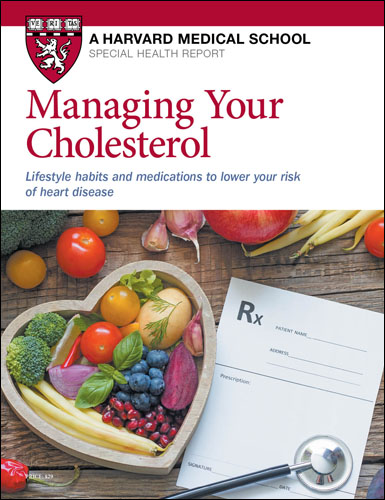Direct-to-consumer genetic tests for heart disease
The results can be challenging to interpret, according to a scientific statement from the American Heart Association.
- Reviewed by Christopher P. Cannon, MD, Editor in Chief, Harvard Heart Letter; Editorial Advisory Board Member, Harvard Health Publishing

Although one of the best-known DNA testing companies, 23andMe, filed for bankruptcy earlier this year, the market for at-home genetic tests is thriving and projected to grow to $7 billion in the next five years. Several companies offer tests that look specifically for heart-related conditions. But the accuracy, reliability, and usefulness of these tests remains questionable, according to a scientific statement from the American Heart Association in the April 8, 2025, issue of Circulation.
“Direct-to-consumer genetic tests provide more democratic access to this type of information. But because of several limitations, the findings aren’t always definitive, and there are potential downsides to using them,” says Dr. Leland Hull, assistant professor of medicine at Harvard Medical School and chair of the writing committee for the statement. Here’s a brief overview of these tests and what they can — and cannot — reveal about heart-related conditions.
How the testing works
After purchasing a direct-to-consumer genetic test, you send the company a DNA sample from saliva or a cheek swab. The company then analyzes your sample with one of two methods:
- Genotyping, the less costly method, identifies known gene variants. This is akin to skimming a book looking for misspellings: you might catch some errors but will likely miss others.
- Sequencing analyzes the entire gene. To use the book analogy, it reads every letter of every word and catches all the misspellings.
The costs, which differ between companies, depend on the type of test, the number of variants studied, and other features. Those that screen for inherited forms of cardiovascular conditions fall into three categories:
Monogenic disease tests. These are rare or uncommon heart conditions that arise from variants in a single gene and include
- dyslipidemias (very high levels of LDL cholesterol and other lipids that greatly increase heart attack risk)
- cardiomyopathies (heart muscle diseases that can lead to heart failure)
- thoracic aortic disease (a condition that causes the body’s major artery to balloon and rupture)
- arrhythmic disorders (defects in the heart’s electrical system that cause life-threatening heart rhythms).
Polygenic disease tests. These include conditions such as coronary artery disease (the root cause of most heart attacks), high blood pressure, and atrial fibrillation. Instead of a single gene, many thousands of gene variants contribute to your risk of these common conditions. You can have zero, one, or two copies of any variant, each of which may either raise or lower your risk. The overall impact of all the variants together — known as a polygenic risk score — is expressed as a percentile. But a high score (for instance, the 95th percentile) doesn’t mean you have a 95% chance for developing the disease. Rather, it means that among 100 people, your score is higher than 95 people and the same as or lower than five.
Pharmacogenetic tests. These tests look at genetic changes that could affect how people respond to or metabolize different medications. In cardiology, the prime example is clopidogrel (Plavix), a drug often prescribed after a heart attack to prevent blood clots. But about 30% of people in this country have a gene variant that makes them less responsive to this medication, leaving them more vulnerable to clots.
Understanding the results
The company typically sends your results to a secure website or app. If you opt for sequencing-based testing for monogenic diseases, the results for each variant are reported, which can include pathogenic (disease-causing) variants, benign variants, and variants of uncertain significance, for which the relationship of the variant to the disease is not currently clear. Our understanding of the relationships between variants and disease have historically been based on data mainly from people with European ancestry. That means that for people of other ethnicities, variants of uncertain significance are more common, and the test results might not be as reliable, Dr. Hull explains. That’s also true for the polygenic risk scores.
Regardless of your ancestry, the results from these tests are not definitive. People with benign or low-risk results can still get heart disease, and those with pathogenic or high-risk findings might not. If you have a pathogenic variant, it should be confirmed by a clinical test ordered by a physician, the American Heart Association advises. Your doctor may then suggest additional testing, including a more detailed blood cholesterol analysis, getting an exercise stress test, or having imaging tests to look at your heart or blood vessels. Depending on the condition, your doctor might refer you to a genetic counselor, who may suggest testing for other family members.
If pharmacogenomic testing reveals you have a CYP2C19 gene variant that makes you less responsive to clopidogrel, you should receive an alternative medication — either prasugrel (Effient) or ticagrelor (Brilinta). These drugs, which are prescribed for people who have had a heart attack or who receive artery-opening stents, are not prescribed routinely because they’re more costly and come with a slightly higher risk of bleeding than clopidogrel.
For most cases of heart disease, your diet and exercise habits play a bigger role than your genes. But if any of your close family members experienced heart problems before age 50, ask your doctor about a possible referral to a genetic counselor. Unlike direct-to-consumer tests, physician-ordered tests might be covered by your insurance.
Image: © Tingting Ji / Rasi Bhadramani Ji/Getty Images
About the Author

Julie Corliss, Executive Editor, Harvard Heart Letter
About the Reviewer

Christopher P. Cannon, MD, Editor in Chief, Harvard Heart Letter; Editorial Advisory Board Member, Harvard Health Publishing
Disclaimer:
As a service to our readers, Harvard Health Publishing provides access to our library of archived content. Please note the date of last review or update on all articles.
No content on this site, regardless of date, should ever be used as a substitute for direct medical advice from your doctor or other qualified clinician.
















